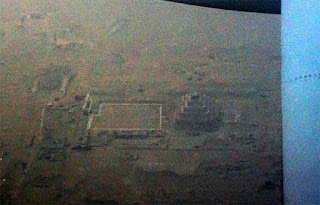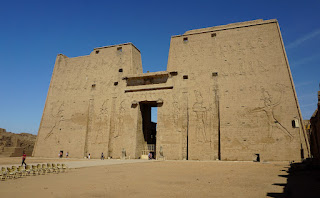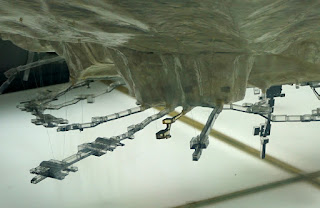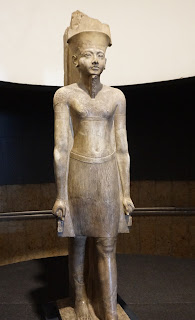March 4-5, 2022
March 4-5, 2022
We rose early this morning, had breakfast, and left just after 6am for a three-hour drive to Abu Simbel. Since our international flight home is late tonight, we can’t risk another flight cancellation. The road South skirts wide of Lake Nasser. It begins with a very flat sandy desert that eventually gives way to scattered mounds in the desert. They look volcanic to me. There is no vegetation whatsoever until we get to the area around Abu Simbel. This locale is being heavily irrigated. Egypt is complaining of Ethiopia draining Nile water, but it seems Egypt is doing the same thing trying to turn the desert into cropland.
After three hours we turn toward Lake Nasser and arrive in the town of Abu Simbel, where the Second or Great Cataract of the Nile once was before being submerged. We are just twenty miles north of the border with Sudan. Interestingly the Nubian houses here all have multiple domes on the roof. Apparently, this helps keep the homes cooler in the intense desert heat.
In Cairo we get an evening room at an airport hotel where we can shower. We go out with the group for our last meal of Egyptian food. At 11pm we head to the airport for our night flight to Paris. There we have a long layover that we spend in the Air France lounge. Then it is a super long flight to Los Angeles and our puddle jumper to Tucson. Humorously over the Irish Sea, I see England's version of the new Texas gold. We have Global Entry now that gets quickly through customs; maybe a little too quickly. As we approached, their cameras spotted and recognized our faces in seconds. We barely had to stop. A little too much ‘Big Brother Watching Me’ for my liking!
This trip to discover ancient Egypt reinforces for me what an amazing and advanced civilization Pharaonic Egypt was. It was vastly ahead of its time. They were so productive to be able to afford leisure time where they could develop a sophisticated culture with a writing system, agriculture, industry, and artistry. This trip only scratched the surface of what ancient Egypt has to offer. Egypt is so much more than the Pyramids.
We rose early this morning, had breakfast, and left just after 6am for a three-hour drive to Abu Simbel. Since our international flight home is late tonight, we can’t risk another flight cancellation. The road South skirts wide of Lake Nasser. It begins with a very flat sandy desert that eventually gives way to scattered mounds in the desert. They look volcanic to me. There is no vegetation whatsoever until we get to the area around Abu Simbel. This locale is being heavily irrigated. Egypt is complaining of Ethiopia draining Nile water, but it seems Egypt is doing the same thing trying to turn the desert into cropland.
After three hours we turn toward Lake Nasser and arrive in the town of Abu Simbel, where the Second or Great Cataract of the Nile once was before being submerged. We are just twenty miles north of the border with Sudan. Interestingly the Nubian houses here all have multiple domes on the roof. Apparently, this helps keep the homes cooler in the intense desert heat.
3300 years ago, Ramses the Great built a great temple here to warn Nubia of his power. His temple is the original Mount Rushmore. Ramses' builders carved a facade of four enormous, seated statues of himself into the Nile cliffside. They continued excavating a temple into the mountain. The temple walls relate the story of Ramses’ heroism at the Battle of Kadesh, one he nearly lost in Palestine against the Hittites. The battle was concluded with the world's first written peace treaty.
Next door is carved a smaller facade and temple to his wife Nefertari, whose tomb we visited in the Valley of the Queens. Aimee is happy to be able to pick out her Cartouche because it contains the recognizable fiddle-shaped hieroglyph, Nefer, meaning beautiful. I am going to start calling Aimee, Nefertari, ‘beautiful companion’.
If the scale of the temples wasn’t amazing enough, their relocation was an astounding feat of civil engineering. The building of the high dam at Aswan threatened to submerge Abu Simbel beneath the Nile waters. In the greatest work of UNESCO, this temple and a dozen others (including Philae) were systematically sawn apart and reassembled on higher ground. We saw one such relocated temple a few years ago in the Metropolitan Museum in NYC. In the case of Abu Simbel they had to build a concrete mountain to support this rock temple!
Next door is carved a smaller facade and temple to his wife Nefertari, whose tomb we visited in the Valley of the Queens. Aimee is happy to be able to pick out her Cartouche because it contains the recognizable fiddle-shaped hieroglyph, Nefer, meaning beautiful. I am going to start calling Aimee, Nefertari, ‘beautiful companion’.
If the scale of the temples wasn’t amazing enough, their relocation was an astounding feat of civil engineering. The building of the high dam at Aswan threatened to submerge Abu Simbel beneath the Nile waters. In the greatest work of UNESCO, this temple and a dozen others (including Philae) were systematically sawn apart and reassembled on higher ground. We saw one such relocated temple a few years ago in the Metropolitan Museum in NYC. In the case of Abu Simbel they had to build a concrete mountain to support this rock temple!
This is a good spot to finish our whirlwind tour of Egypt since it was the Abu Simbel scenes in the movie Death on the Nile that inspired this trip. Now we need to make the long trip back across the length of Egypt. So it is three hours back to Aswan where we catch a ninety-minute flight to Cairo. I was happy to see us pass over the Step Pyramid on our approach. That is where great Egyptian history started and also where we began our tour.
In Cairo we get an evening room at an airport hotel where we can shower. We go out with the group for our last meal of Egyptian food. At 11pm we head to the airport for our night flight to Paris. There we have a long layover that we spend in the Air France lounge. Then it is a super long flight to Los Angeles and our puddle jumper to Tucson. Humorously over the Irish Sea, I see England's version of the new Texas gold. We have Global Entry now that gets quickly through customs; maybe a little too quickly. As we approached, their cameras spotted and recognized our faces in seconds. We barely had to stop. A little too much ‘Big Brother Watching Me’ for my liking!
 |
| Jewelry Making in Tomb of Mereruka |
















































